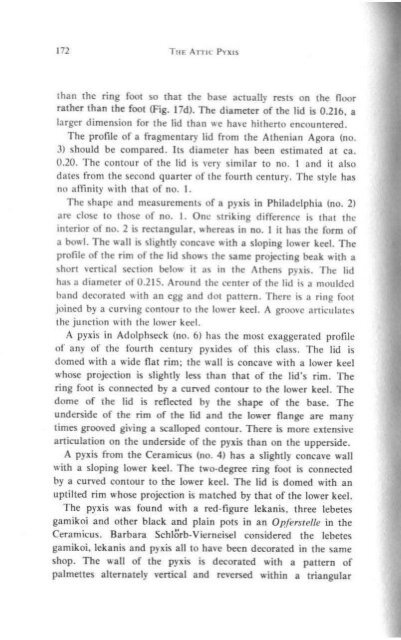You also want an ePaper? Increase the reach of your titles
YUMPU automatically turns print PDFs into web optimized ePapers that Google loves.
172 TIIF ATTIC PYltl~<br />
SALLY RUTUERFIJIlO ROBEaTs<br />
I7J<br />
than the ring fOOl so that the base actually rests on the floor<br />
rather tban Ihe fOOt (Fig. 17d). The diameter of the lid is 0.216, a<br />
larger dimension for the lid than wc ha\c hitherto encountered.<br />
The profile of a fragmentary lid from the Athenian Agora (no.<br />
J) should be compared. Its diameter has been estimated at ca.<br />
0.20. The contour of the lid is ,,'cry similar to no. I and it also<br />
dates from the second quarter of the fourth cemury. The style has<br />
no affinity .... ilh that of no. I.<br />
The shape and mcasurcmcnb of a pyxis in Philadelphia (no. 2)<br />
are dose 10 those of no. I. Onc l>lriking difference is that the<br />
interior of no. 2 is rectangular. whereas in no. I it has the fonn of<br />
a bowl. The wall is slightly COnC3\'C \,1.ith a sloping lo.....er keel. The<br />
profile of lhe rim of the lid shows Ih~ same pro~cting beak with a<br />
shon vertical s«lion below il as In the Athens pp,is. The lid<br />
has a diameter orO.215. Around the l-enter of the lid i~ a moulded<br />
band decorated .... ith an egg and dot pattern. There is a ring foot<br />
joined by a curving contour 10 Ihe lo.... er keel. A groove articulate..<br />
the junction with the lower keel.<br />
A pyxis in Adolphseck (no. 6) has the most exaggerated prolile<br />
of any of the fourth century pyxides of this class. The lid is<br />
domed with a wide flat rim; the wall is conca\'e with a lower keel<br />
whose projection is slightly less than that of th~ lid's rim. The<br />
ring foot is connected by a cun'ed contour to the lower keel. The<br />
dome of Ihe lid is reflected by the shape of the base. The<br />
underside of the rim of the lid and the lo.....er flange are many<br />
times grooved ghing a scalloped contour. There is more extensi\'e<br />
articulation on the underside of the pyxis than on the uppersid~.<br />
A pyxis from the Ceramicus (no. 4) has a slightl)' eonca\'e wall<br />
with a sloping lower keel. The N'o-degree ring foot is connected<br />
by a curved contour to the lo.....er keel. The lid is domed with an<br />
uptilted rim whose projection is matched by that of the lower keel.<br />
The pyxis was found with a red-figure lekanis, three lebetes<br />
gamikoi and olher black and plain pots in an Opfersrelle in the<br />
Ceramicus. Barbara Schlorb·Vierncisel considered the lebetes<br />
gamikoi, lekanis and pyxis all to have been decorated in the same<br />
shop. The wall of the pyxis is decorated with a pallern of<br />
palmettes alternately vertical and reversed within a triangular<br />
frame. This is an unusual pattern to find instead of the customary'<br />
.... re:uh of Iea\·es. The lekanis wall also carries the same pattern<br />
and the subject of the figured fri~ze interpreted by Schlorb<br />
Vierneisel as Epaulia on both lids is the sam~. Therefore the<br />
theme decorating the pyxis. leaknis and lebetes gamikoi is<br />
coordinated and the vases boughl for onc occasion probably here<br />
(l funeral. One must here envision matched sets of red·figured<br />
vaSL'S made in a shop and decorated Ilo'ith regard to a particular<br />
theme decorating the pyxis, lekanis and lebetC1 gamikoi is<br />
a range of vase: shapes to be made by a potter or pott~rs within a<br />
ghen shop. In addition. it seems logical to expect in time to be<br />
able to auribute \ases .....ithin this vase repertory to a painter or<br />
group of painters, once a t)pe of ,ase Ilo ithin the repertory has betn<br />
attributed to an :artiSI. A proof for the conjectural S~I of '-ase-; is<br />
prodded by Ihe repr~entation on a Kerch lekanis lid. Athens 1190<br />
(Iromispiece). A bride sits on a klisnlos .... ith Ems leaning against<br />
her A full set of vases is grouped around her. To the leH a lebes<br />
galllikus 311d a 10\\ broad pyxis. type C, to the right a tall pyxis of<br />
type A. a lebes gamikos 3nd a lckallis. Another lebes gamikos is<br />
brought by a woman.<br />
Funher evidence of th~ "matched set" comes from the<br />
Athcni:lIl Agor3. 1\ lekanis loo and the lid of a pyxis type AlS ha\'e<br />
the same pallerns. Oblique addorsed palmenes linked by a<br />
running scroll is Ihe main pattern on each. The subsidiary<br />
patterns are also the same on OOth_ These pieces do not have the<br />
same prrn'enance Iol.ithin the Agora but clearly come from th~<br />
same shop.<br />
This paltern seems to emerge around 430 a.C. The Marlay<br />
Painter is known to have decorated leb~tes gamikoi and pyxides<br />
as well as 10utrophoroi. l6 One would expect Itl find the<br />
loutrophoros made .....ithin the same shop from its related them~.<br />
Many lebetes gamikoi. !outrophoro; and a pyx;s are attributed to<br />
the Washing !)ailllerY Loutrophoroi and lekanidL'S have been<br />
attributed to the Mcidias Painter. JI Lebeles gamikoi. loulrophoroi.<br />
lckanides and pyxidcs are among the repertory of shapes attributed<br />
to the manner of Ihe Meidias Paintcr. Jt Lebetes gamikoi and a<br />
lekanis ha\Ce been attributed 10 Ihe fourth century Mars}'3s<br />
Painter.~

















